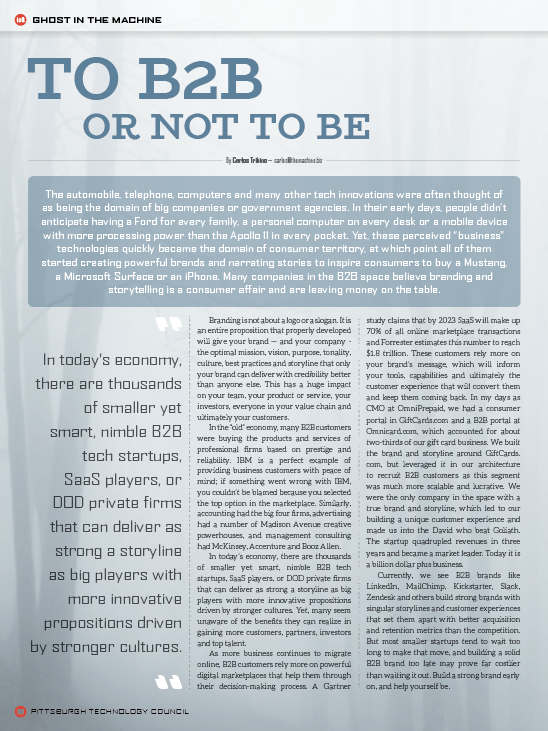To B2B Or Not to Be?
By Carlos Tribino, The Machine
 The automobile, telephone, computers and many other tech innovations were often thought of as being the domain of big companies or government agencies. In their early days, people didn’t anticipate having a Ford for every family, a personal computer on every desk or a mobile device with more processing power than the Apollo 11 in every pocket. Yet, these perceived “business” technologies quickly became the domain of consumer territory, at which point all of them started creating powerful brands and narrating stories to inspire consumers to buy a Mustang, a Microsoft Surface or an iPhone. Many companies in the B2B space believe branding and storytelling is a consumer affair and are leaving money on the table.
The automobile, telephone, computers and many other tech innovations were often thought of as being the domain of big companies or government agencies. In their early days, people didn’t anticipate having a Ford for every family, a personal computer on every desk or a mobile device with more processing power than the Apollo 11 in every pocket. Yet, these perceived “business” technologies quickly became the domain of consumer territory, at which point all of them started creating powerful brands and narrating stories to inspire consumers to buy a Mustang, a Microsoft Surface or an iPhone. Many companies in the B2B space believe branding and storytelling is a consumer affair and are leaving money on the table.
Branding is not about a logo or a slogan. It is an entire proposition that properly developed will give your brand — and your company - the optimal mission, vision, purpose, tonality, culture, best practices and storyline that only your brand can deliver with credibility better than anyone else. This has a huge impact on your team, your product or service, your investors, everyone in your value chain and ultimately your customers.
In the “old” economy, many B2B customers were buying the products and services of professional firms based on prestige and reliability. IBM is a perfect example of providing business customers with peace of mind; if something went wrong with IBM, you couldn’t be blamed because you selected the top option in the marketplace. Similarly, accounting had the big four firms, advertising had a number of Madison Avenue creative powerhouses, and management consulting had McKinsey, Accenture and Booz Allen.
In today’s economy, there are thousands of smaller yet smart, nimble B2B tech startups, SaaS players, or DOD private firms that can deliver as strong a storyline as big players with more innovative propositions driven by stronger cultures. Yet, many seem unaware of the benefits they can realize in gaining more customers, partners, investors and top talent.
As more business continues to migrate online, B2B customers rely more on powerful digital marketplaces that help them through their decision-making process. A Gartner study claims that by 2023 SaaS will make up 70% of all online marketplace transactions and Forrester estimates this number to reach $1.8 trillion. These customers rely more on your brand’s message, which will inform your tools, capabilities and ultimately the customer experience that will convert them and keep them coming back. In my days as CMO at OmniPrepaid, we had a consumer portal in GiftCards.com and a B2B portal at Omnicard.com, which accounted for about two-thirds of our gift card business. We built the brand and storyline around GiftCards.com, but leveraged it in our architecture to recruit B2B customers as this segment was much more scalable and lucrative. We were the only company in the space with a true brand and storyline, which led to our building a unique customer experience and made us into the David who beat Goliath. The startup quadrupled revenues in three years and became a market leader. Today it is a billion dollar plus business.
Currently, we see B2B brands like LinkedIn, MailChimp, Kickstarter, Slack, Zendesk and others build strong brands with singular storylines and customer experiences that set them apart with better acquisition and retention metrics than the competition. But most smaller startups tend to wait too long to make that move, and building a solid B2B brand too late may prove far costlier than waiting it out. Build a strong brand early on, and help yourself be.